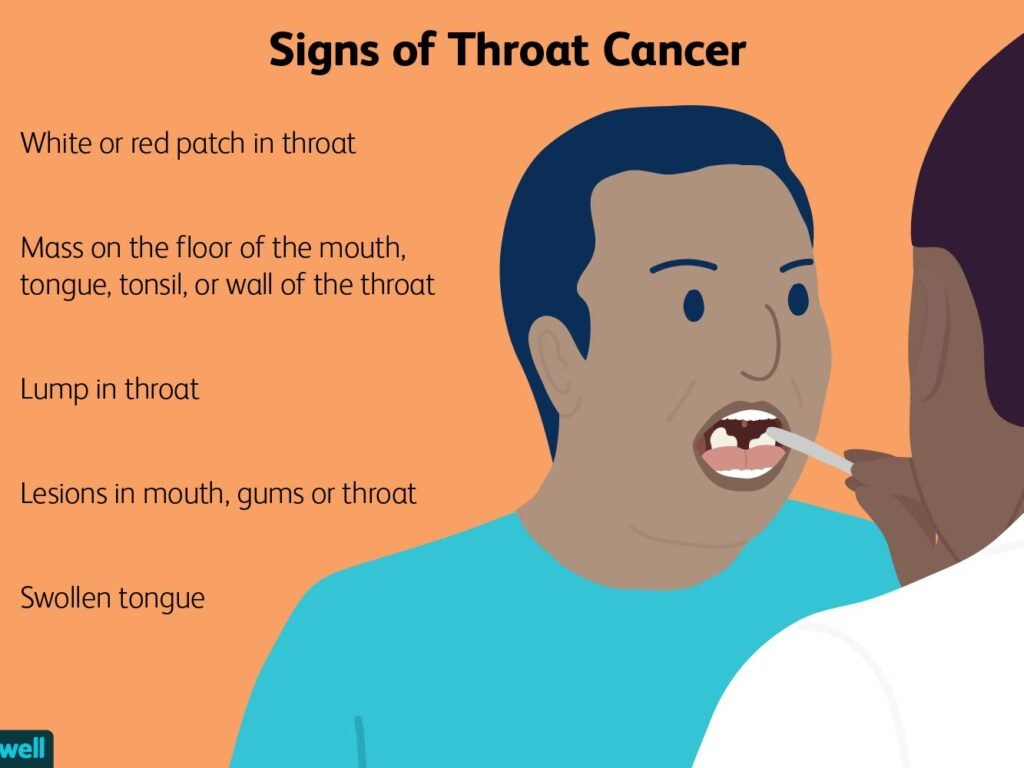
Throat Cancer
Cancer can develop from tissues in the mouth, tongue, larynx, salivary glands. Symptoms include. Sore throat that does not heal or a change in the voice.
The throat is a tube-like structure that starts behind the nose and ends in the neck legion. It covers the vocal box, vocal cord, tonsil area, and pharynx.
It is a group of cancer associated with the throat area, which involves more than one part of the throat. Throat cancer happens when cells grow in an uncontrolled way in part of the throat.
Types of throat cancer:
- Nasopharyngeal Cancer begins in the nasopharynx just behind your nose.
- Laryngopharyngeal cancer begins in the laryngopharynx above the esophagus and windpipe.
- Oropharyngeal Cancer begins in the oropharynx behind your mouth that includes tonsils.
- Many types of throat cancer begin as:
- Squamous cell Carcinoma: It affects flat cells lining the throat. Squamous cell carcinoma affects the layers of the throat.
- Adenocarcinoma: It affects the glandular structure or the glandular cells of the throat.
- Tonsil cancer and lymph nodes come under adenocarcinoma.
Staging of Throat Cancer:
Stage 1: Carcinoma in situ. In stage 1 mild symptoms like sore throat, recurrence of infection, tonsillitis.
Stage 2: Tumor is larger than 2 cm, not reached the lymph nodes.
Stage 3: Cancer spreads to a lymph node on the same side of the neck.
Stage 4: Most advanced state of throat cancer, the tumor may be of any size, spread to nearby tissue, trachea, thyroid, esophagus, or other locations. Spread distant parts of the body beyond the throat.
Causes:
The cause of throat cancer is not known exactly.
Risk Factors:
- Alcohol.
- Tobacco smoking is the main risk factor.
- Diet: poor nutrition, vitamin deficiencies may play a role.
- Human Papillomavirus: it increases risk factors, HPV16 is the causing factor.
- Epstein: Barr virus.
- Gastroesophageal reflux diseases: stomach acid that flows up through the
- esophagus can damage its lining.
- Smoking or chewing tobacco such as gutka or pan.
- Weekend immune system.
- Exposure to the petroleum industry.
- Exposure to wood dust or paint fumes (prolonged).
- Genetic syndromes.
- Family history.
Symptoms:
- Chronic hoarseness of the throat.
- Sore throat does not heal for a long time.
- Weight loss.
- Swollen lymph nodes.
- Recurrent fever.
- Difficulty in swallowing food.
- Pain in the throat and ear.
- Change in voice.
Symptoms According to the location or site:
1. Mouth: - Fungal infection in an advanced stage.
- Difficulty in swallowing even water.
- Sore throat.
- Change in voice.
- Loss of taste.
2. Nasopharynx: - Difficulty in breathing via the nose.
- Loss of smell.
- Pain in the cartilage of the nose.
- Blocking of nose passage.
Prevention: - Choosing a healthy diet pattern.
- Avoid regular intake of alcohol.
- Avoid smoking.
- Protection from Human Papillomavirus.
- People who work in chemical factories should maintain proper ventilation.
- Keep healthy oral hygiene.
- Proper intake of fruits and vegetables.
- A regular dental examination may identify precancerous lesions in the oral cavity.
Diagnosis:
- USG: ultrasound of head and neck region.
- CT-Scan: to see soft tissue or an internal organ.
- MRI-Scan: to see the overall picture of the throat from inside.
- X-Ray.
- PET-Scan.
- Biopsy.
- Fine needle aspiration.
- Barium test.
Homeopathic Treatment:
- Homeopathic treatment can treat throat cancer patients by helping them in the removal of the painful symptoms of cancer.
- It helps in controlling the growth of cancer cells, by reducing the size of already developed tumors.
- Nausea while eating, unhealed wounds, fungal infection, all these complications are well managed with our medicines.
- Our medicine boosts the energy of patients by recovering the weakness of cancer.
- Homeopathic medicines treat the patient as a whole.
- We have medicines that control or remove the side effects of chemotherapy, radiotherapy, and hormonal therapy.